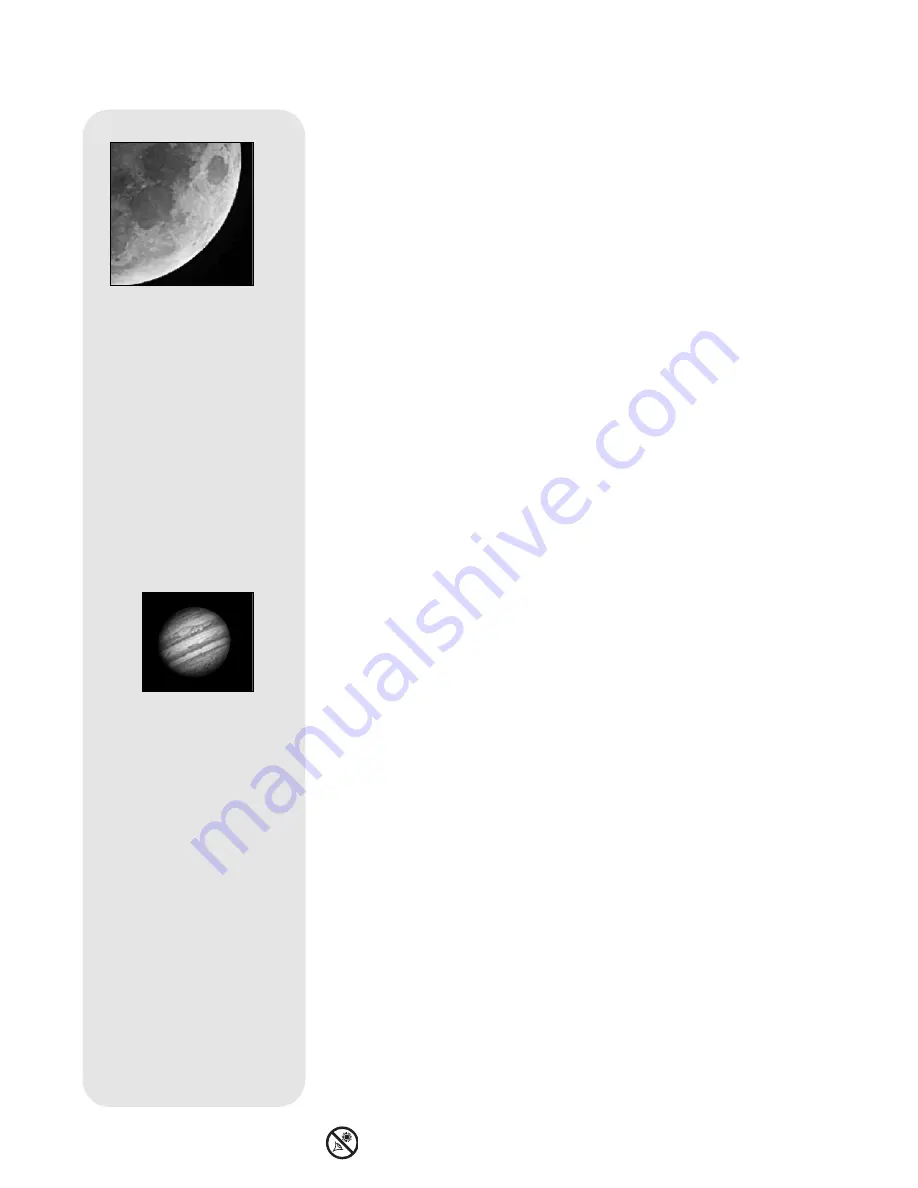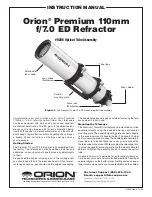
13
Look for different features on the Moon:
The most obvious features are craters. In fact
you can see craters within craters. Some craters have bright lines about them. These
are called rays and are the result of material thrown out of the crater when it was
struck by a colliding object. The dark areas on the Moon are called maria and are
composed of lava from the period when the Moon still had volcanic activity. You can
also see mountain ranges and fault lines on the Moon.
Use a neutral density filter (sometimes called a “moon filter”) when observing the
Moon. Neutral density filters are available from Meade as an optional accessory.
Spend several nights observing the Moon. Some nights, the Moon is so bright that it
makes other objects in the sky difficult to see. These are nights that are excellent for
lunar observation.
Observe the Solar System:
After observing the Moon, you are ready to step up to the
next level of observation, the planets. There are four planets that you can easily
observe in your telescope: Venus, Mars, Jupiter and Saturn.
Nine planets (maybe more...3 more planets have been discovered in the "Oort" cloud
at print time) travel in a fairly circular pattern around our Sun. Any system of planets
orbiting one or more stars is called a solar system. Our Sun, by the way, is a single,
dwarf star. It is average as far as stars go and is a middle aged star.
Beyond the planets are clouds of comets, icy planetoids and other debris left over
from the birth of our sun (the Oort cloud). Recently astronomers have found large
objects in this area and they may increase the number of planets in our solar system.
The four planets closest to the Sun are rocky and are called the inner planets.
Mercury, Venus, Earth and Mars comprise the inner planets. Venus and Mars can be
easily seen in your telescope.
Venus is seen before dawn or after sunset, because it is close to the Sun. You can
observe Venus going through crescent phases. But you cannot see any surface detail
on Venus because it has a very thick atmosphere of gas.
When Mars is close to the Earth, you can see some details on Mars, and sometimes
even Mars’ polar caps. But quite often, Mars is further away and just appears as a red
dot with some dark lines crisscrossing it.
Jupiter, Saturn, Uranus, Neptune and Pluto comprise the outer planets. These
planets, except for Pluto, are made mostly of gases and are sometimes called gas
giants. If they had grown much bigger, they may have become stars. Pluto is made
mostly of ice.
Jupiter is quite interesting to observe. You can see bands across the face of Jupiter.
The more time you spend observing these bands, the more details you will be able
to see.
One of the most fascinating sights of Jupiter are its moons. The four largest moons
are called the Galilean moons, after the astronomer Galileo, who observed them for
the first time. If you’ve never watched the Galilean moons in your telescope before,
you’re missing a real treat! Each night, the moons appear in different positions around
the Jovian sky. This is sometimes called the Galilean dance. On any given night, you
might be able to see the shadow of a moon on the face of Jupiter, see one moon
eclipse another or even see a moon emerge from behind Jupiter’s giant disk. Drawing
the positions of the moons each night is an excellent exercise for novice astronomers.
Any small telescope can see the four Galilean moons of Jupiter, plus a few others, but
how many moons does Jupiter actually have? No one knows for sure! Nor are we
sure how many Saturn has either. At last count, Jupiter had over 60 moons, and held
a small lead over Saturn. Most of these moons are very small and can only be seen
with very large telescopes.
The planet Jupiter. Jupiter's four
largest moons can be observed in a
different position every night.
Craters of the Moon are excellent
targets to observe.
Looking at or near the
Sun
will cause
irreversable
damage to your eye. Do not point
this telescope at or near the Sun. Do not look through the telescope as it is moving.
Содержание LightBridge Truss Tube 10
Страница 1: ...Instruction Manual 8 10 12 16 LightBridge Truss Tube Dobsonian Telescopes MEADE COM...
Страница 22: ......
Страница 23: ......










































